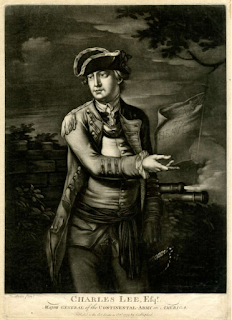The Mysterious Mezzotints of Thomas Hart
In October the American Revolution Institute published an intriguing article about a British print in its collection, one of only two known copies. (The other copy is at the Yale University Art Gallery.)
The image is titled “The Hero returned from Boston,” and its stated origin is: “London. Printed for Thos. Hart, as Act directs, 7th Sepr. 1776.”
The blog post adds more nuance:
We have multiple images of some of those American Patriots, such as Washington, Hancock, and Gates. In those cases, scholars have no trouble looking at a picture from the same period by Charles Willson Peale or John Singleton Copley and seeing how little the European prints resemble them. Take a look for yourself.
But in other cases, such as Hopkins, Wooster, and Charles Lee (shown above), we have so few portraits that for many decades people have copied or reprinted what are clearly unreliable pictures. I may well have done so myself (except I rarely have anything to say about Hopkins and Wooster, and I like the caricature of Lee with his dog better).
After all, some period image may seem better than nothing at all. But is it?
TOMORROW: Interpreting the oddball etching.
The image is titled “The Hero returned from Boston,” and its stated origin is: “London. Printed for Thos. Hart, as Act directs, 7th Sepr. 1776.”
The blog post adds more nuance:
The name of the publisher, Thomas Hart, is associated with a series of fictitious portraits of American leaders, including George Washington (including one on horseback and one on foot), John Hancock, Israel Putnam, David Wooster, Horatio Gates, Charles Lee, Esek Hopkins, Benedict Arnold, John Sullivan, and John Paul Jones, dated between 1775 and 1779. These prints, all of which are mezzotints, are attributed to publishers Thomas Hart, C. Shepherd, and John Morris.Before we go on to that mystery, I want to pause to consider the implications of the Hart/Shepherd/Morris portraits being unreliable.
None of these prints bears any real resemblance to its subject, despite the publishers’ effort to persuade customers that they were authentic likenesses. . . . The portraits were mostly fraudulent, turned out quickly to meet public demand for images of the leaders of the American rebellion. All of the prints may, in fact, have been produced for the London market in Augsburg, a German city that was a center of commercial print production. Their style—the markedly heavy features, large eyes, dark shadows, and treatment of details of clothing and accoutrements—is characteristic of Augsburg engravings.
Even more curious, the names of Thomas Hart, C. Shepherd, and John Morris seem to be fictitious as well. With one exception, their names are not associated with any other prints. The only plausible explanation for the use of these fictitious names is that the true publishers wanted to profit by selling images of the American Revolutionaries but preferred not to be closely associated with these products, which were, after all, heroic images of traitors who had taken up arms against the king.
The Hero returned from Boston is the outlier among the odd prints published by the fictitious Thomas Hart. It is the only etching, with aquatint or otherwise, associated with Hart’s name. The Hero returned from Boston is also the only one of the Hart prints in which the subjects are not named. Who is the hero returned from Boston? And who is the woman clinging so provocatively to him?
We have multiple images of some of those American Patriots, such as Washington, Hancock, and Gates. In those cases, scholars have no trouble looking at a picture from the same period by Charles Willson Peale or John Singleton Copley and seeing how little the European prints resemble them. Take a look for yourself.
But in other cases, such as Hopkins, Wooster, and Charles Lee (shown above), we have so few portraits that for many decades people have copied or reprinted what are clearly unreliable pictures. I may well have done so myself (except I rarely have anything to say about Hopkins and Wooster, and I like the caricature of Lee with his dog better).
After all, some period image may seem better than nothing at all. But is it?
TOMORROW: Interpreting the oddball etching.


No comments:
Post a Comment